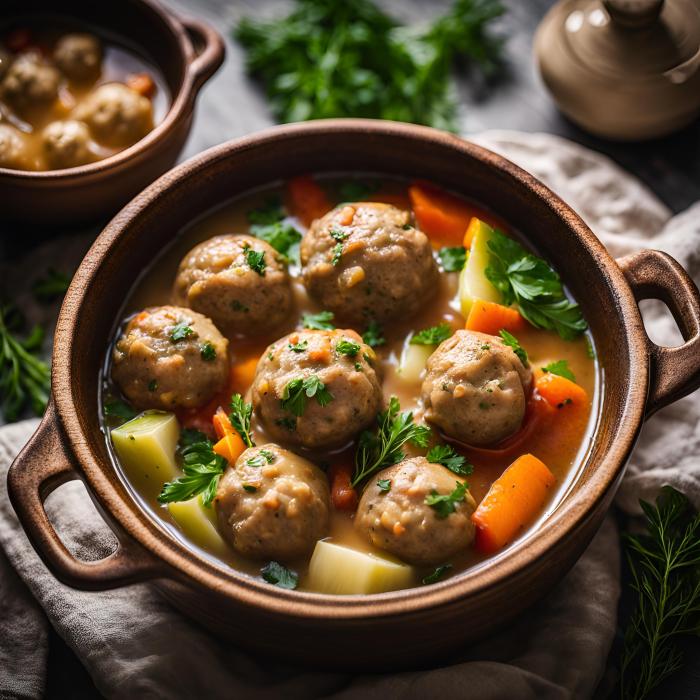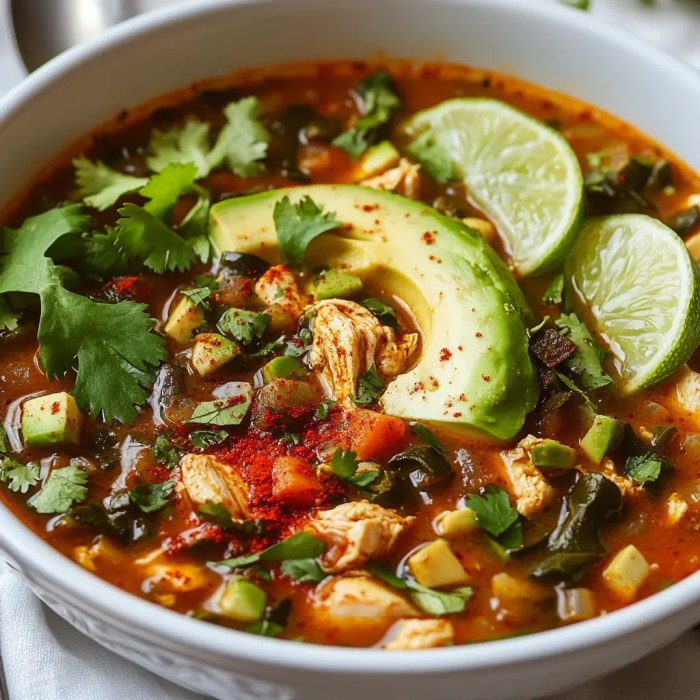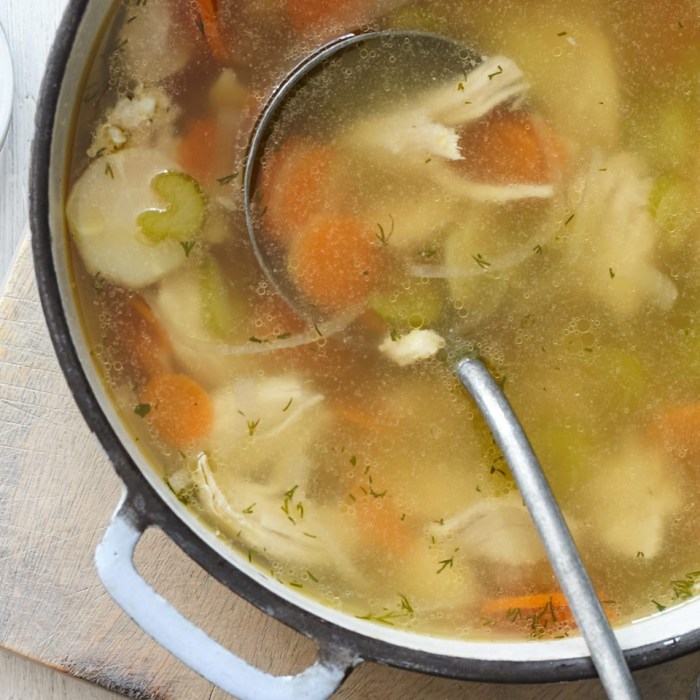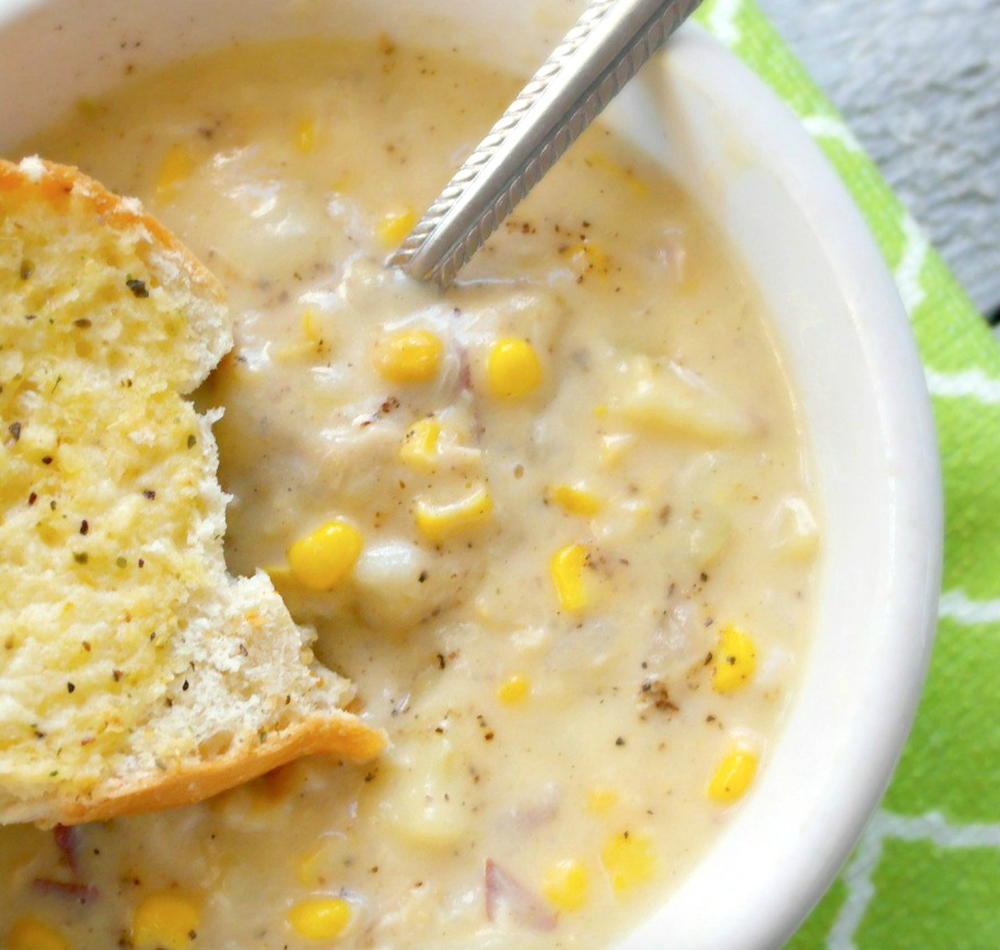Chicken Vegetable Soup Recipe Variations
Recipe chicken vegetable soup – This section explores diverse chicken vegetable soup recipes, showcasing cultural influences and catering to various dietary needs. We will examine variations emphasizing specific cuisines, dietary restrictions, and unique vegetable combinations.
Cultural Variations of Chicken Vegetable Soup
The versatility of chicken vegetable soup allows for exciting global interpretations. Here are five examples highlighting different culinary traditions:
- Italian Chicken Vegetable Soup (Minestrone-inspired): This version incorporates small pasta (ditalini or orzo), cannellini beans, and a generous amount of fresh basil and oregano. A touch of Parmesan cheese adds a savory richness.
- Asian Chicken Vegetable Soup: This variation features ginger, garlic, soy sauce, and a medley of Asian vegetables like bok choy, shiitake mushrooms, and baby corn. A light sesame oil drizzle enhances the aromatic profile.
- Mexican Chicken Vegetable Soup (Caldo de Pollo-inspired): This soup is characterized by the use of fire-roasted tomatoes, chipotle peppers for a smoky heat, and corn. Cilantro and lime juice provide a refreshing finish.
- French Chicken Vegetable Soup: This version often features root vegetables like carrots, parsnips, and potatoes, along with leeks and celery. Thyme and bay leaf provide an earthy herbaceous note. A touch of cream or crème fraîche adds richness.
- Indian Chicken Vegetable Soup: This soup incorporates warming spices like turmeric, cumin, coriander, and garam masala. Vegetables such as spinach, cauliflower, and peas are common additions. A squeeze of lemon juice brightens the flavor.
Dietary-Specific Chicken Vegetable Soup Recipes
Adapting chicken vegetable soup to meet specific dietary needs is straightforward. The following recipes cater to low-sodium, vegetarian, and gluten-free diets:
- Low-Sodium Chicken Vegetable Soup: This recipe minimizes salt by using herbs, spices, and lemon juice to enhance flavor. Low-sodium chicken broth is essential.
- Vegetarian Chicken Vegetable Soup: Replace chicken with hearty vegetables like mushrooms, lentils, or chickpeas for a protein-rich vegetarian alternative. Vegetable broth provides the base flavor.
- Gluten-Free Chicken Vegetable Soup: Ensure all ingredients, including broth and seasonings, are certified gluten-free. Avoid adding any gluten-containing ingredients like barley or certain types of pasta.
Chicken Vegetable Soup with Unusual Vegetables
Expanding beyond common vegetables adds depth and intrigue to chicken vegetable soup. A recipe featuring less common vegetables could include:
This recipe uses a base of chicken broth, carrots, celery, and onions, but then incorporates romanesco broccoli (for a unique visual appeal and slightly nutty flavor), radicchio (for bitterness that balances sweetness), and sunchokes (for a slightly sweet and earthy flavor). A touch of fresh rosemary adds a pleasant herbal note.
Recipe Comparison Table
This table compares preparation, cooking times, and approximate calorie counts for three variations of chicken vegetable soup.
| Recipe | Preparation Time (minutes) | Cooking Time (minutes) | Approximate Calories (per serving) |
|---|---|---|---|
| Classic Chicken Vegetable Soup | 20 | 45 | 250 |
| Asian Chicken Vegetable Soup | 15 | 30 | 200 |
| Mexican Chicken Vegetable Soup | 25 | 50 | 280 |
Ingredient Selection and Sourcing
The quality of ingredients significantly impacts the final flavor and nutritional value of your chicken vegetable soup. Careful selection and sourcing are key.
Chicken Selection
Different types of chicken offer varying flavor profiles and cooking times. For soup, bone-in chicken pieces (thighs and drumsticks) are preferred as they render more collagen, resulting in a richer, more flavorful broth. Chicken breasts, while leaner, tend to become dry during prolonged cooking. Rotisserie chicken can be a convenient shortcut, offering a flavorful base but lacking the depth of homemade broth.
Vegetable Selection, Recipe chicken vegetable soup
A wide variety of vegetables can be incorporated into chicken vegetable soup. Classic choices include carrots (for sweetness and beta-carotene), celery (for subtle bitterness and crunch), and onions (for savory depth). Other nutritious and flavorful options include potatoes, green beans, peas, corn, spinach, and mushrooms. Each vegetable contributes unique nutritional benefits and flavor nuances.
Fresh vs. Frozen Vegetables
While fresh vegetables generally offer superior taste and texture, frozen vegetables are a convenient and often equally nutritious alternative. Frozen vegetables are flash-frozen at their peak ripeness, locking in nutrients. However, they might lack the vibrant color and crispness of fresh vegetables. The choice depends on convenience and availability.
Ingredient Substitutions
Flexibility is key when making chicken vegetable soup. Here are some common substitutions:
- Chicken Broth: Vegetable broth (for vegetarian versions), beef broth (for a richer flavor), or even water (with added seasonings) can be substituted.
- Carrots: Sweet potatoes, parsnips, or turnips can provide similar sweetness and texture.
- Celery: Leeks or fennel can offer a similar subtle bitterness.
- Onions: Shallots or leeks can add a different layer of flavor.
Cooking Techniques and Methods
Mastering broth-making and understanding optimal cooking times for vegetables are crucial for creating a delicious and nutritious chicken vegetable soup.
Broth-Making Techniques

Source: tasteofhome.com
There are several ways to make chicken broth, each impacting the final flavor. Simmering bone-in chicken with aromatics (onions, carrots, celery) in water for several hours yields a rich, collagen-infused broth. Using pre-made broth is a convenient shortcut, but may lack depth of flavor.
Optimal Cooking Times for Vegetables
Different vegetables require different cooking times to achieve optimal texture and flavor retention. Harder vegetables like carrots and potatoes should be added earlier, while more delicate vegetables like spinach and peas should be added towards the end of the cooking process.
Thickening Techniques
Several methods can be used to thicken chicken vegetable soup. A roux (a mixture of butter and flour) creates a creamy consistency. Cornstarch slurry (cornstarch mixed with cold water) is another effective thickening agent. Pureeing a portion of the soup with an immersion blender also adds body and creaminess.
Step-by-Step Soup Preparation
The following steps Artikel a basic chicken vegetable soup recipe:
- Sauté onions, carrots, and celery in olive oil until softened.
- Add bone-in chicken pieces and cook until lightly browned.
- Pour in water or broth, add herbs and spices, and bring to a boil.
- Reduce heat and simmer for at least 1 hour, or until chicken is tender.
- Remove chicken from the pot and shred the meat.
- Add other vegetables (potatoes, green beans, etc.) and simmer until tender.
- Stir in shredded chicken and season to taste.
- Thicken the soup if desired.
Serving Suggestions and Presentation
Elevating the presentation and serving style of chicken vegetable soup enhances the overall dining experience. Creative garnishes and thoughtful pairings complement the soup’s flavors.
Serving Suggestions

Source: cheffrecipes.com
- Classic Serving: Serve hot in bowls, garnished with fresh herbs (parsley, chives), a swirl of cream, and a crusty bread roll.
- Elevated Serving: Serve in elegant bowls, garnished with a drizzle of high-quality olive oil, toasted croutons, and a sprinkle of grated Parmesan cheese. Pair with a side salad.
- Hearty Serving: Serve in mugs, topped with shredded chicken, a dollop of sour cream or Greek yogurt, and a sprinkle of paprika. Pair with a grilled cheese sandwich.
Visual Presentation

Source: recipesbyjulia.com
A visually appealing presentation enhances the enjoyment of chicken vegetable soup. Serve in attractive bowls, ensuring a balance of colors and textures. Garnishes should be strategically placed to create visual interest. Consider using contrasting colors and textures to create a visually appealing presentation.
Reheating Leftovers
Reheat leftover soup gently on the stovetop or in the microwave, avoiding excessive boiling which can alter the texture and flavor. Adding a splash of broth or water can help restore the soup’s consistency.
Meal Prepping and Freezing
Chicken vegetable soup is ideal for meal prepping and freezing. Allow the soup to cool completely before storing in airtight containers. Frozen soup can be stored for up to 3 months.
Nutritional Information and Health Benefits: Recipe Chicken Vegetable Soup
Chicken vegetable soup offers a nutritious and wholesome meal, rich in essential vitamins, minerals, and antioxidants. Understanding its nutritional profile and health benefits helps in making informed dietary choices.
Nutritional Breakdown (Sample Recipe)
A typical serving (approximately 1.5 cups) of chicken vegetable soup may contain approximately:
- Calories: 250-300
- Protein: 20-25 grams
- Fat: 5-10 grams
- Carbohydrates: 25-35 grams
- Fiber: 5-8 grams
Note: Nutritional values vary depending on the specific ingredients and quantities used.
Health Benefits of Key Ingredients
The key ingredients in chicken vegetable soup contribute numerous health benefits. Chicken is a good source of lean protein. Vegetables provide vitamins, minerals, and fiber, promoting digestive health and overall well-being. The broth itself can be soothing and hydrating.
A comforting chicken vegetable soup is a classic, brimming with fresh ingredients and hearty flavors. For a richer, more decadent option, consider exploring alternative protein sources; a fantastic example would be the incredibly flavorful prime rib soup recipe , which offers a completely different taste profile. However, for a lighter, everyday meal, the simplicity of a well-made chicken vegetable soup is hard to beat.
Benefits and Drawbacks of Regular Consumption
Regular consumption of chicken vegetable soup can be beneficial as part of a balanced diet. It provides essential nutrients and can contribute to weight management. However, excessive sodium intake from broth or added salt can be detrimental to health. Therefore, opting for low-sodium options and controlling salt additions are recommended.
Nutritional Profile (Text-Based)
This soup is a good source of protein, fiber, and various vitamins and minerals. It is relatively low in fat and can be adapted to be low in sodium. The nutritional profile is highly variable based on the specific ingredients included.
FAQ Corner
Can I use bone-in or boneless chicken?
Both work well! Bone-in chicken adds richer flavor to the broth, but boneless cooks faster.
How long can I store leftover soup?
Store leftover soup in an airtight container in the refrigerator for up to 3-4 days.
Can I freeze this soup?
Yes! Freeze in airtight containers for up to 3 months. Allow to thaw completely before reheating.
What are some good alternatives to chicken broth?
Vegetable broth provides a vegetarian option. You can also use a combination of water and bouillon cubes for a simpler approach.


